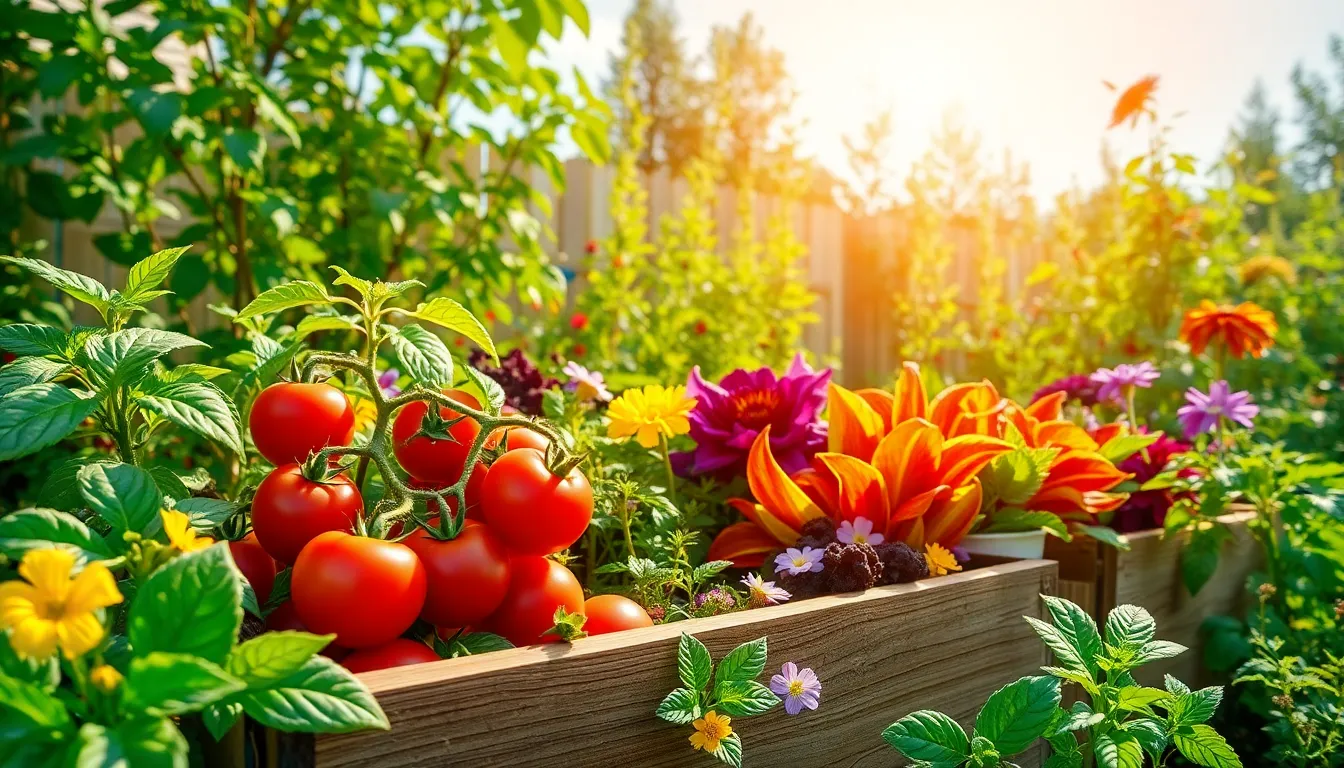Imagine stepping into your backyard and being greeted by a vibrant oasis of fresh veggies and fragrant herbs. Backyard gardening isn’t just a hobby; it’s a delightful escape into nature that can transform any ordinary space into a lush paradise. With a little dirt under your nails and a sprinkle of sunshine, anyone can cultivate a green thumb—yes, even that friend who can’t keep a houseplant alive!
Backyard Gardening
Backyard gardening offers numerous advantages that contribute to both personal well-being and environmental health. Engaging in this activity fosters a greater connection to food, nature, and community.
Physical Health Benefits
Backyard gardening promotes physical fitness. Lifting soil bags, digging, and planting exercises muscles and improves cardiovascular health. Fresh air and sunlight boost vitamin D levels, benefiting overall health. Nutrient-rich fruits and vegetables grown at home enhance dietary quality. Research indicates that a varied diet supports immune function and reduces disease risks.
Mental Health Benefits
Mental well-being improves through gardening. Spending time outdoors elevates mood, reducing anxiety and stress levels. Nature exposure triggers the release of endorphins, leading to feelings of happiness. Gardening also encourages mindfulness, as individuals focus on growth, planting, and nurturing. Studies show that green spaces can decrease symptoms of depression and promote overall life satisfaction.
Environmental Impact
Backyard gardening positively impacts the environment. Home gardens reduce carbon footprints by cutting down on food transportation emissions. They contribute to biodiversity by providing habitats for pollinators and other wildlife. Organic gardening methods decrease reliance on chemical pesticides, promoting healthier ecosystems. Additionally, more individuals growing food in their gardens lessens strain on commercial agricultural systems.
Getting Started With Backyard Gardening

Backyard gardening requires careful planning and thoughtful decisions. Understanding your space and selecting the right plants are crucial steps.
Choosing The Right Location
Selecting a suitable location is vital for plant growth. Look for areas that receive at least 6 hours of sunlight daily. Consider proximity to water sources for easy irrigation. Avoid spots with heavy shade from trees or structures. Assess drainage; avoid areas that collect standing water after rainfall. Additionally, ensure accessibility for regular maintenance and harvesting.
Selecting Plants For Your Garden
Deciding on plants shapes the garden’s success and beauty. Begin with easy-to-grow vegetables and herbs like tomatoes, basil, and lettuce. Choose plants that thrive in your climate zone for optimal results. Research companion planting to maximize space and enhance growth; for example, plant marigolds alongside vegetables to deter pests. Evaluate the space available; raised beds or containers can accommodate smaller areas. Including a mix of flowering plants supports pollinators and adds color.
Essential Tools And Supplies
Essential tools and supplies make backyard gardening efficient and enjoyable. Being well-equipped enhances the gardening experience, ensuring productivity and ease.
Gardening Tools
Gardening tools include a variety of implements essential for planting and maintaining a garden. Trowels serve to dig and transplant seedlings. Hand pruners allow for easy trimming of plants and herbs. Additionally, garden forks help aerate soil, promoting healthy root growth. Watering cans facilitate efficient watering, ensuring plants receive adequate moisture. Gloves protect hands during work, providing comfort and preventing injuries. Each tool contributes to a successful gardening experience by simplifying tasks and improving efficiency.
Soil And Fertilizers
Soil and fertilizers play a critical role in plant health and growth. Quality soil provides nutrients, drainage, and support for roots. Gardeners often use a mix of topsoil and compost for enriched planting areas. Organic fertilizers enhance nutrient availability, promoting vibrant plant life. Examples include compost, shredded leaves, and well-rotted manure. Regular soil testing helps determine nutrient levels, guiding fertilizer application. Healthy soil with proper fertilization leads to abundant yields and thriving plants within the backyard garden.
Maintenance And Care
Maintenance and care play crucial roles in ensuring a thriving backyard garden. Regular attention leads to healthier plants and a more productive environment.
Watering Techniques
Watering techniques should account for plant needs and weather conditions. Deep, infrequent watering encourages root growth, as moisture reaches deeper soil layers. Morning is often the best time to water, as less evaporation occurs. Drip irrigation systems efficiently deliver water directly to the soil, minimizing waste. Consider using soaker hoses for a gentle watering technique that saturates the soil evenly. Monitoring soil moisture levels through a finger test helps determine when to water; sticking a finger into the soil up to two inches can provide insight into the moisture status.
Pest Control
Pest control methods can protect plants from harmful insects. Integrated Pest Management (IPM) blends multiple strategies to minimize pest damage. Monitoring for signs of pest activity early leads to timely interventions. Neem oil offers an effective organic option for controlling pests while remaining safe for beneficial insects. Introducing natural predators, such as ladybugs and lacewings, helps maintain ecological balance in the garden. Handpicking larger pests provides a direct solution for small infestations. Planting herbs and flowers that repel pests can also deter unwanted visitors naturally.
Seasonal Considerations
Seasonal changes play a significant role in backyard gardening. Understanding these changes helps maximize plant growth and overall success.
Spring Planting
Spring marks an exciting time for gardeners. Choosing the right time to plant ensures healthy growth. Soil should warm up to around 60°F before planting. Cool-season crops, like lettuce and peas, thrive during early spring. In contrast, warm-season vegetables, such as tomatoes and peppers, require a later planting after the last frost. Starting seeds indoors can jumpstart growth and provide a head start. Additionally, using row covers can protect young plants from unexpected cold snaps. A successful spring planting sets a strong foundation for a productive garden.
Fall Preparation
Fall preparation is crucial for garden longevity. Clearing out spent plants reduces the risk of pests and diseases. This practice also allows for the incorporation of organic matter, like compost, enriching the soil. Cover crops may be sown during fall to improve soil health. Selecting suitable cover crops, such as clover or rye, enhances nitrogen levels. As the temperatures drop, mulching around plants helps protect roots from freezing. Planning for next spring during the fall offers valuable insight, guiding plant selection and garden layout for optimal yield.
Conclusion
Backyard gardening offers a fulfilling way to enhance one’s outdoor space while reaping numerous health and environmental benefits. By engaging with nature and growing fresh produce, individuals can improve their physical and mental well-being. The journey of gardening fosters a deeper connection to food and the environment, promoting sustainable practices that benefit the planet.
With the right planning and care, anyone can cultivate a thriving garden. From selecting the perfect location to choosing the right plants and employing effective maintenance techniques, every step contributes to a rewarding gardening experience. Embracing this hobby not only enriches personal lives but also nurtures the community and ecosystem. The beauty of backyard gardening lies in its simplicity and the joy it brings to those willing to dig in and grow.

